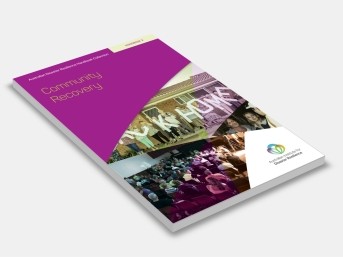Community Recovery: Australian Disaster Resilience Handbook Collection
Australian Government
This handbook aims to provide a comprehensive guide to community recovery in Australia. It is intended for use by planners, managers and those involved in working with communities to design and deliver recovery processes, services, programs and activities.
The first edition of this handbook, the Australian Emergency Manual Recovery, was developed in 1996. Over the past two decades, many structural changes have occurred in the governance systems and policy development arenas of emergency management and recovery management. This handbook has been updated to reflect those changes.
The term ‘recovery worker’ is a generic description. Recovery workers may be practitioners from organisations and disciplines in any and every field who are involved in delivering services to the community in non-disaster times, and who may become recovery workers following a disaster. The issues confronted by individuals and communities, and the knowledge and skills needed to navigate the post-disaster community environment, are considerable. There is a need for shared understanding that can aid discourse among practitioners, policy makers and administrators.
The goals of this handbook are:
to explore key concepts, theories and practice frameworks in evidence in Australia
to contribute towards a common language to enable sector-wide discourse
to provide concepts, knowledge and resources for practitioners
to increase confidence, autonomy, innovation, critique and reflective practice for those assisting communities in recovery.
Many of the essential components of the original publications have been incorporated into this handbook. It has been updated in terms of policy, procedures and professional practice developments, and also considers community resilience and sustainability considerations.
Contents:
Australian Disaster Resilience Handbook Collection
Acknowledgements
Jurisdictional Arrangements For Community Recovery
About This Handbook
Community Recovery Handbook Companion Documents
Part 1: Introduction To Community Recovery
Part 2: Policies And Principles That Support Community Recovery
Part 3: Planning For Recovery
Part 4: Recovery Environments
List Of Figures:
Figure 1: Programs And Activities Supporting Disaster Prevention, Preparedness, Response And Recovery (Some Terminology May Differ Across States/Territories And Nationally)
Figure 2: Extract From The National Principles For Disaster Recovery
Figure 3: The National Principles For Disaster Recovery
Figure 4: Different Phases That Individuals And Communities Might Experience Post Disaster
Figure 5: Effect Of Disaster On Ongoing Community Development And Interface With Relief And Recovery
Figure 6: Recovery Communication Management—Communicating With The Various Stakeholders Through Various Means
Figure 7: The Four Environments—Integral Aspects Of Community Recovery
Figure 8: The Project Cycle As It Applies To Emergency Recovery Management
Figure 9: Community-Driven Needs Assessment Process
Figure 10: The Multi-Layered Aspects Of Community
Figure 11: Stresses And Wellbeing Impact
Figure 12: Psychosocial Recovery—Balancing Individuals, Households, Neighbourhoods
Figure 13: Adapted From The Inter-Agency Standing Committee Intervention Pyramid For Mental Health And Psychosocial Support In Emergencies
Figure 14: Key Questions To Assist With Determination Of Recovery Actions For The Natural Environment
List Of Tables:
Table 1: Overview Of Common Myths And Assumptions Of What Disaster-Affected People Need Compared To Social Recovery Activities And Services Typically Provided
Table 2: Summary Of WHO Predictions Of The Prevalence Of Psychosocial Problems After An Emergency
Table 3: Typical Reactions That People Exposed To A Traumatic Event May Experience
Table 4: Key Recovery Stakeholders
Table 5: Outline Of Some Of The Impacts That May Be Experienced By Households And Businesses Following An Emergency Event
Table 6: Examples Of Direct Economic Effects Of Disaster By Sector/Area Of Impact
Table 7: Examples Of Indirect Economic Effects Of Disaster By Sector/Area Of Impact
Table 8: Examples Of Intangible Economic Effects Of Disaster By Sector/Area Of Impact
Table 9: Examples Of Impacts Of Disasters On The Natural Environment By Component
Table 10: Examples Of Recovery Activities (Risk Treatment Options) In The Natural Environment Listed By Component
